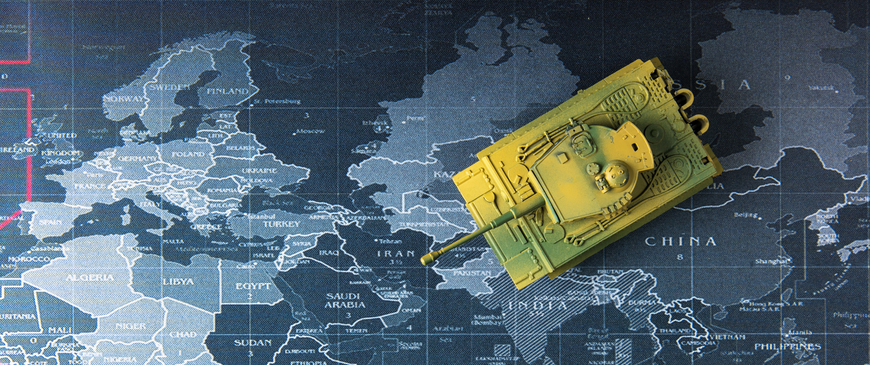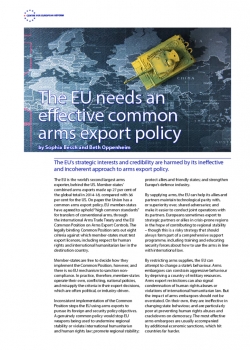
The EU needs an effective common arms export policy
The EU’s strategic interests and credibility are harmed by its ineffective and incoherent approach to arms export policy.
The EU is the world’s second largest arms exporter, behind the US. Member-states’ combined arms exports made up 27 per cent of the global total in 2014-18, compared with 36 per cent for the US. On paper the Union has a common arms export policy. EU member-states have agreed to uphold “high common standards” for transfers of conventional arms, through the international Arms Trade Treaty and the EU Common Position on Arms Export Controls. The legally binding Common Position sets out eight criteria against which member-states must test export licences, including respect for human rights and international humanitarian law in the destination country.
Member-states are free to decide how they implement the Common Position, however, and there is no EU mechanism to sanction non-compliance. In practice, therefore, member-states operate their own, conflicting, national policies, and misapply the criteria in their export decisions, which are often political, or industry-driven.
Inconsistent implementation of the Common Position stops the EU using arms exports to pursue its foreign and security policy objectives. A genuinely common policy would stop EU weapons being used to undermine regional stability or violate international humanitarian and human rights law; promote regional stability; protect allies and friendly states; and strengthen Europe’s defence industry.
By supplying arms, the EU can help its allies and partners maintain technological parity with, or superiority over, shared adversaries; and make it easier to conduct joint operations with its partners. Europeans sometimes export to strategic partners or allies in crisis-prone regions in the hope of contributing to regional stability – though this is a risky strategy that should always form part of a comprehensive support programme, including training and educating security forces about how to use the arms in line with international law.
By restricting arms supplies, the EU can attempt to change a state’s behaviour. Arms embargoes can constrain aggressive behaviour by depriving a country of military resources. Arms export restrictions can also signal condemnation of human rights abuses or violations of international humanitarian law. But the impact of arms embargoes should not be overstated. On their own, they are ineffective in changing state behaviour, and are particularly poor at preventing human rights abuses and crackdowns on democracy. The most effective arms embargoes are usually accompanied by additional economic sanctions, which hit countries far harder.
EU arms export policy is also closely linked to efforts to build up the EU’s defence industrial base. Because of the low level of defence spending in Europe, European defence firms rely heavily on exports to sustain themselves. As a result, European industries sometimes prioritise the capability needs of export customers over those of EU states. Between 2014 and 2018, 90 per cent of France’s arms exports and 73 per cent of Germany’s went to buyers outside the EU, while in 2017, 89 per cent of UK arms exports went outside Europe.
The EU’s solution, through initiatives like the European Defence Fund, is to create greater economies of scale in European production. The idea is not to encourage EU member-states only to ‘buy European’, but to help them be more selective about whom they export to. At the same time, joining forces to develop a new capability, like the next European fighter jet, requires countries and their defence industries to trust each other to provide components. Arms export policies need to be predictable and consistent.
In order to force countries to adhere to the Common Position, the EU would have to introduce a sanctions mechanism. The EU could establish a supervisory arms export body under the control of the Commission or the High Representative, which could report on violations of the Common Position by member-states. If the infringement continued, the Commission could refer it to the European Court of Justice. But creating a sanctions mechanism would require treaty change.
The biggest obstacle to a common arms policy however, is that EU member-states often disagree on their analysis of a conflict and the EU’s interests in it. For instance, member-states diverge on whether supplying weapons to Saudi Arabia will help stabilise or destabilise the Gulf region and what the impact on European security would be. Ultimately, there is no consensus on threat perception and strategic assessment.
At present member-states have little appetite for surrendering decision-making power over arms exports. But in future the EU’s institutions may try to exert more control. After years of staying out of the defence realm, long considered a bastion of national sovereignty, the European Commission is progressively carving out a role for itself.
Even before that, the EU could improve transparency to aid decision-making. The Council’s Working Party on Conventional Arms Exports (COARM) produces an annual report compiling member-states’ statistics on conventional arms licences and exports. The report should become a searchable online database. Many member-states, including France, the UK and Germany, still fail to submit full reports on their export licences on time. The EU should establish strict reporting deadlines and standardise the format of reports. Some countries struggle to provide the required data due to lack of resources or know-how. COARM should arrange peer review meetings, where governments can exchange best practices on how to gather such data from industry.
The EU should implement stronger end-use controls at the European level. Exported weapons can and do end up in the wrong hands. A 2017 report found that more than 30 per cent of the arms used by IS fighters in Syria and Iraq came from Bulgaria, Romania, Hungary and Germany. The EU could encourage and support member-states in implementing post-shipment controls. EU resources, such as expert teams made up of Commission or European External Action Service staff, dispatched to EU delegations in the buying country, could be employed to help with controls.
Finally, export-specific agreements between small groups of member-states that want to work together on a capability project could slowly build trust and contribute to greater convergence. But in order to strengthen rather than erode EU foreign policy objectives, these agreements would have to include a binding commitment to abide by the EU’s export criteria.
Without a common and enforceable EU arms export regime, divergence – and therefore weakened EU power and legitimacy – is inevitable. But conversations with EU officials and industry figures make it clear that a supervisory arms export body backed up by a compliance mechanism is at best a long-term possibility, for which there is no consensus at present.
For now, EU member-states should attempt to reach consensus on the threat environment in which arms exports are taking place, improve reporting by member-states, tighten end-use controls and reach inter-governmental export agreements. New EU defence initiatives and the increasing role of the Commission suggest the relationship between national sovereignty and defence is shifting. Europe will benefit if it can keep moving towards convergence on arms export policy.
Sophia Besch is a research fellow and Beth Oppenheim is a researcher at the Centre for European Reform.

